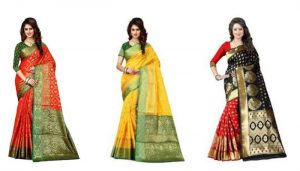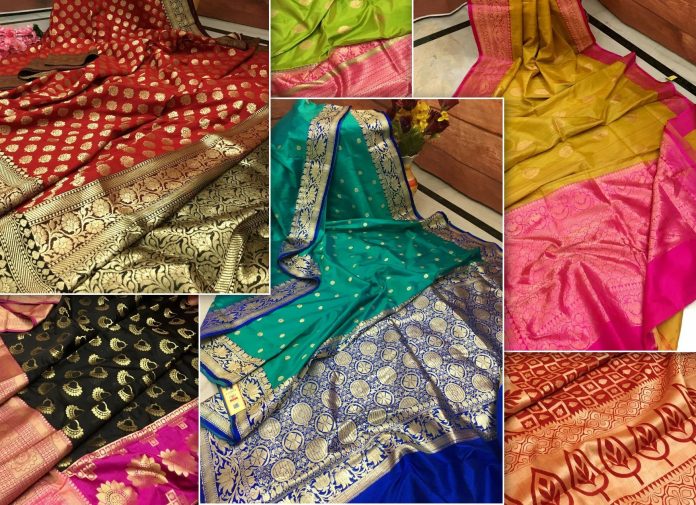The saree is the national dress for Indian women and it’s a significant piece of the women’s life. Most women embellish the saree to any event as a result of its style and advancement. The Banarasi saree isn’t just mainstream as a component of the marriage wears in Bengal weddings yet women from all religions and societal positions love this saree. This Banarasi saree isn’t just causing a ripple effect in the Indian design industry yet additionally in the global style world.
This ethnic wear has numerous complicated and complex plans woven into the six yards that make this saree dazzling. Indeed, even with innovation, Varanasi still uses hand-weaving methods to weave unpredictable plans with gold and silver strings to make this Banarasi saree. These lovely and exquisite sarees have become well known and each lady’s first decision with regards to sarees. Their stylish and fascinating weavings by fashioners who use zari, themes, and emeralds have gotten the most loved among women over the world.
History of Banarasi silk sarees

The historical backdrop of Indian sarees goes back to the Hindu folklore of Ramayana in the 1000 to 300 B.C. Banarasi silk was acquainted with India by the Mughal Empire with its multifaceted weaving and structuring craftsmanship. The Banarasi silk today has a blend of two distinct societies, the Mughals and Indian. In the days of yore, silk for this saree was imported from China; these days the silk is sourced from the Southern pieces of India.
Indian sarees are divided into two general classifications the conventional marriage and the originator portion. Banarasi sarees are marriage sarees that are exceptionally mainstream due to their different surfaces, hues, and structures.
Features of Banarasi silk sarees

The wholesale Banaras sarees are made in Varanasi in Uttar Pradesh. They are one of the best customary sarees in India and overwhelming because of its rich weaving which makes them perfect for gatherings, celebrations, and weddings. This saree is generally made in four assortments in particular organza (Kora), Georgette saree, Shatir saree, and unadulterated silk (Katan). The numerous assortments of Banarasi silk saree are organza, glossy silk outskirts, jangle, Brocades, Tanchoi, cutwork, and Resham butidar that have fascinating plans of creatures, winged animals, botanical, natural product, human figures, and geometric examples.
Persian themes are additionally remembered for the Indian structures to make unmistakable bloom examples of the saree utilized even today. The Banarasi sarees were initially adorned with strings produced using genuine gold and silver for the illustrious family. For them to be reasonable these days for everybody, the strings have been supplanted with hued gold and silver strings. This acclaimed saree has eye-getting examples and shades woven on a handloom and dispatched everywhere throughout the world.
Making of a Banarasi saree

It typically takes around 15 to 30 days to finish weaving a Banarasi saree. Be that as it may, it relies upon the unpredictability of the structure and examples. Regularly 3 weavers are required in the production of this saree. One weaves the saree, the subsequent one handles the rotating ring in making packs, and the third one aids outskirt structuring. Making the Banarasi saree requires cooperation. In a perfect world, a Banarasi saree has around 5600 string wires and all are 45 inches wide. The skilled workers make a base of 24-26 inches in length. Structuring the themes starts at the packaging stage.
A craftsman made structure sheets by outlining the plans on a diagram paper alongside shading ideas. Punch cards are then made before choosing the last plan then several punctured cards are made to suit a solitary structure for a saree. To weave the punctured cards on the loom, various hues and strings are utilized. The punctured cards are then rowed in an efficient way to guarantee the primary weave gets the correct hues and examples.
Banarasi saree designs

The Banarasi saree is divided into classes like Tissue, Butidar, Cutwork, Tanchoi, and Jangal. Tissue sarees are woven with brilliant Zari Brocade to add sheen to the saree. The saree’s outskirts and pallu are designed with self-woven paisleys. Bidar sarees are woven with brocade strings silver, silk, and gold. The darker shade of gold contrasted with the silver strings has earned the brocade designing the name Ganga-Jamuna.
Cutwork sarees are the more affordable adaptation of Jamdani sarees. They are results of the cutwork procedure on a plain surface. Leaves, jasmine, creepers, and marigold blossoms are mainstream themes highlighted on Cutwork sarees. Tanchoi sarees designs are woven with brilliant weft silk yarns. The adornments on this saree are enormous themes of paisleys and the fringe has jumble designs.
Jangal sarees are woven with brilliant silk strings it’s enlivened with perplexing examples of Jangala themes and vegetation that fall along with the saree. The lavish texture with multifaceted structures and specifying makes this Banarasi saree perfect for wedding works that can be found at style carpet online stores.
Banarasi saree’s fabric varieties

The Banarasi saree has four principle texture assortments, Georgette, Shatter, Organza with zari and silk, and Katan.
Georgette is a finely woven light texture that is made of crepe yarn between woven with both twist and weft. It is famous in planning salwar kameez outfit structures, Bollywood wholesale cotton sarees, and originator sarees. Shatter texture is utilized to create wonderful contemporary and elite Banarasi saree plans.
Organza is a lavishly woven texture with the most lovely Brocade examples and plans that are made by twist and weft. Gold-covered silver strings are woven around the silk yarns to deliver zari brocade.
Katan is a plain texture that has woven unadulterated silk strings that make unadulterated silk sarees. In the past times, Katan saree’s lovely themes and examples were woven utilizing handlooms yet these days, they are created utilizing fast weaving machines power looms.
Conclusion
India is the underdog to China is silk creation. India sends out its silk to more than 200 nations around the globe and the interest is expanding particularly in Europe and America. These conventional and shocking Banarasi silk sarees are perceived internationally because of the one of a kind examples and complicated structures made on the sarees. Bollywood superstars and well-known characters are currently wearing wholesale sarees catalog for weddings, exceptional events, or capacities. The Banarasi saree is an absolute necessity have in the closet.







